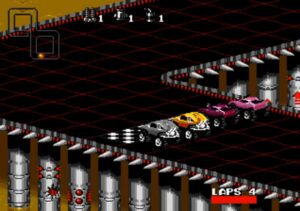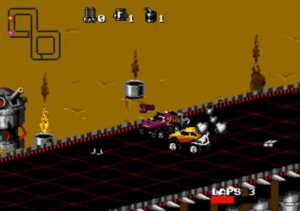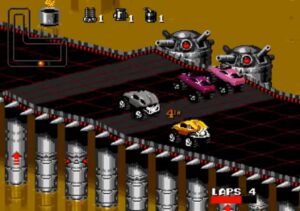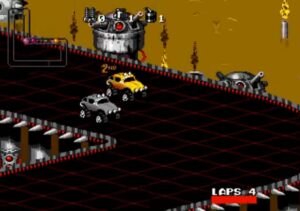This game provides the following examples:
- A.I. Breaker: It’s not something you can really induce, but on tracks with a turn that you’re not supposed to take, sometimes the AI will fumble and get tripped up, taking the wrong turn and essentially eliminating themselves from the race by going the wrong way without trying to reorient.
- Car Fu
- Cat Girl: Katarina Lyons of Panteros V.
- The Computer Is a Cheating Bastard: On Warrior, the other racers start with a number of upgrades before you even get the chance to take on the first race. Most noticeably, they have several shots when you have one. Viper may even have more shots than the game will let you get!
- Cool Car: While most of the cars resemble monster truck chassis with sexy car bodies added on top, this game made hovercrafts a slick and dangerous entry in this trope.
- Do Well, But Not Perfect: Not in races, but in car upgrades. A rather important detail is that the HP of your opponents is directly related to your own. The more armor upgrades you buy, the more they’ll have, meaning the more abuse both of you can take before popping. If you prefer to race aggressively, it’ll do you well to avoid upgrading your armor completely so that you can still blast your opponents in just a couple of shots.
- Early Game Hell: On Warrior the other racers have superior firepower compared (among other things) to you, and getting the Air Blade is a tall order. You also essentially have to go without upgrades to get the aforemented vehicle, which you can soundly upgrade until the Battle Trak becomes available. It does help a LITTLE to buy two shots for your starting clunker, since that’ll at least afford you the ability to gun down one opponent per lap, if you don’t mind being set back a bit. In all likelyhood, Viper, Rip, and Shred will dominate you until you get that Air Blade, then Grinder will eat you alive until you get enough missiles and boost charges to outrun and outgun him, then you’re in the clear for a while.
- Easy-Mode Mockery: Limited what planets you could race on (and thus what cars you had access to), depending on the difficulty setting. The lowest ends the game after three planets, saying to choose Veteren. The last planet was only playable on the highest setting, and to make it more challenging, the tracks from it weren’t available in the practice mode (where you could choose the planet you wanted to race on).
- Fake Longevity: Each planet consists of two divisions, requiring you to run each track at least twice (more if you didn’t score first place.) Winning each race only awards $10,000, which requires several races to afford each upgrade step. Also, upgrades do not persist if you purchase a new car (even for a new paint job.)
- Guest Fighter: Olaf from The Lost Vikings appears as a racer in this game.
- Idiosyncratic Difficulty Levels: Rookie, Veteran and Warrior.
- Isometric Projection: Like the 8-bit NES classic, R.C. Pro-Am.
- Power Up Letdown: The Havac again. Its weapon, the Sundog Beam, is difficult to use and, more importantly, ridiculously weak compared to the Rogue Missiles.
- Punny Name: Most of the racers. Dark Age of Supernames also figures heavily.
- RPG Elements: Each car can have multiple upgrades added to their separate parts, including engine, wheels, suspension, armor and weapons. You also need to win so many races to reach a new “racing division.”
- Secret Character: Olaf and the super-rich, super-statted racer unlocked with a code.
- Shout-Out: Several characters.
- Olaf is from Silicon & Synapse’s previous game, The Lost Vikings.
- Snake Sanders (of Terra) is visually based off Whitesnake singer David Coverdale.
- Jake Badlands is named for Jake E. Lee.
- Cyberhawk is likely a reference to both the cover of the Judas Priest album Screaming for Vengeance and the ’80s cartoon Silverhawks.
- Captain Braddock looks eerily similar to Snake Plissken.
- Track Champ of the Week
- Vehicular Combat: Oils slicks, metal tacks, mines, grenades, plasma fire, missiles, heat-seeking orbs of death and just ramming the other guy into the rail.
- Wacky Racing
- You Break It, You Profit: The more you destroy your opponents, the more winnings you receive.
Passwords
Passwords are given out at the beginning of each new “racing season” (each planet has its own definition of how many races make up a season, but early advancement will automatically start a new season), and they are located at the bottom of the F/X screen (accessible from the menu between races). These passwords are a complex code, consisting of three 4-digit sections, and they dictate everything about the players’ progress: the character used, the vehicle type and color, weapons and parts upgrades, racing planet and division, difficulty setting, and money. The Game Boy Advance version of the game uses an EEPROM chip to save the player’s progress in lieu of the password system.
The password codes only allow the player to save a maximum of $999,990 (six digits); if there are more than six figures in the bank account, the password truncates the leftmost digits over six (e.g. if there’s $1,002,000 when the player quits, there will be only $2,000 when using the password to continue later). Due to the two-player password function, it’s possible to “cheat” by entering the same password for both players or by entering passwords for players who were at entirely different points in the game. The password with the lowest difficulty setting and on the earliest planet and racing division will be used as the basis for play from then on, which allows for a Warrior-skill character with a maxed-out vehicle to race against Rookie-class AIs in the Rookie skill mode.
Though a password generator QBASIC program exists, the passwords it creates often result in a glitch, causing the player to race on glitchy planets—that exist only as a bug and can crash the game—after racing on Inferno. In the Rookie skill mode, however, they work perfectly, as long as one doesn’t try to take the character beyond the third planet using the password.
Bonuses and Items
Rock n’ Roll Racing offers various bonuses and items that can turn the tide of a race:
- Power-Ups: Collect power-ups scattered throughout the tracks to gain temporary advantages such as speed boosts, oil slicks, or homing missiles.
- Currency: Earn money by winning races and use it to upgrade your vehicle’s armor, weapons, and engine for improved performance.
- Track Hazards: Watch out for hazards like oil slicks, landmines, and jumps that require careful navigation to avoid losing valuable positions.
Strategically utilizing these bonuses and items can give you the edge needed to secure victory.




Sequel
The front cover of Rock & Roll Racing 2: Red Asphalt
A sequel to the original Rock N’ Roll Racing was made for the 32-bit PlayStation console by Interplay. The game was sold in Europe as Rock & Roll Racing 2: Red Asphalt and in the United States as just Red Asphalt.
It featured an Underground comix style in the character’s profiles & ending-videos, a system to upgrading each character’s driving/combat skills similar to RPG games and also contained new Hi-Quality soundtracks of Experimental, Electro-Industrial tendencies.
The game didn’t become as popular as the first, most likely due to Interplay’s closure near the time of the game’s release. Also, it retained little of the gameplay that had made the first game so unique and popular.
Red Asphalt Gameplay Soundtrack
- “Wreck” by Ronald Valdez
- “Trashed” by Brian Luzietti
- “Dead Ass meth” and “Holocaust del Puerco” – performed by Nature, mixed by Brian Taylor
- “Road Killers“, “Overkill“, “Cleaner“, and “Head Voices” – composed and performed by Rick Schaffer, Womb Music Studios
- “Intensity” and “Slingshot” – composed and performed by Johann Langlie, Guitar: Curtis Matthewson, Bass: Deon Estus, Drums: Dean Butterworth
Rock n’ Roll Racing Gameplay
Gameplay is identical between versions.
The goal of the game is to progress through all the planets’ race leagues. Each planet’s league has two divisions of a set amount of races. The top three finishers of each race get some money and some league points.
To pass the division and rank up to the next division or planet, the player needs to collect enough points by the end of the season. If the player collects enough points before the end of the season they can rank up immediately.
With the money the player collects, they can upgrade their car or buy new ones. Upgrades include armor, engines, tires, and the number of powerups the player can use during the race.
Powerups come in three different types: Hazards, Projectiles, and Mobility.
As the game difficulty goes up, the AI will become more and more willing to unleash their arsenal of powerups during the race. As the enemies get tougher, the game evolves from simply going faster than the opponents to a struggle to survive.
The Sega Genesis version has the distinct advantage of having more tracks. In the Super Nintendo and Gameboy Advance versions, the tracks repeat when the player graduates from Division B to Division A. In Rock n’ Roll Racing for Sega Genesis, the player is treated to a whole new set of race tracks for each division.
There are important differences between controllers. For the Super Nintendo version, B is gas, and the other three face buttons are powerups. L and R can be used to steer the car.
The problem lies in the fact that the player will be holding the gas button as they put the balls to the walls. The mobility powerup is used with the top X button, so if the player wants to use a boost, they will need to take their thumb off the B button for a moment to press the X button.
Alternatively, if the player’s claw skills are good enough this shouldn’t be a problem, but the problem is solved with the Gameboy Advance. The other two powerups are bound to the shoulder buttons, making it easier to take advantage of the entire arsenal.
The lack of shoulder buttons isn’t a problem for the genesis version because the powerup buttons surround the gas button, so the player doesn’t have to ease up on the gas in order to let a missile fly or drop a mine in front of a rival.
Rock n’ Roll Racing delivers a fiercely captivating experience filled with high flying missiles, lasers, ramming opponents into the wall, and midair explosions. The glory of a first place finish is fought for and earned.
Characters and Abilities
Rock n’ Roll Racing features a roster of memorable characters, each with their own distinct abilities and playstyles:
- Snake Sanders: Known for his aggression and speed, Snake excels at ramming opponents and taking the lead.
- Tarquinn: A skilled technician with excellent handling and the ability to repair his vehicle during races.
- Jake Badlands: Possessing a powerful jump ability, Jake can leap over obstacles and gain an advantage on the track.
- Cyberhawk: Equipped with advanced weaponry, Cyberhawk can devastate opponents with missiles and lasers.
Choose your favorite racer and utilize their unique abilities to outmaneuver rivals and cross the finish line first.
Rock n’ Roll Racing Soundtrack
Without a doubt, the most important part of Rock n’ Roll Racing is the soundtrack.
With all the enemies to blast and drifting around the corners, a high octane game like this needs a matching soundtrack.
And to make a soundtrack that will go down in legend, Silicon & Synapse needed a legendary video game composer.
And that legendary video game composer needed to….
Actually, Silicon & Synapse just licensed a handful of classic rock songs and called it a day. Now check out these rocking jams.
- Bad to the Bone by George Thorogood and the Destroyers
- Highway Star by Deep Purple
- Paranoid by Black Sabbath
- Peter Gunn by Henry Mancini
- Born to be Wild by Steppenwolf
- Radar Love by Golden Earring
Never before has a more worth ensemble of rock n’ roll fury been put together for a videogame.
The Genesis soundtrack gets the privilege of having one more song of its soundtrack than the other versions, and that track is Radar Love.
The Super Nintendo and Gameboy Advance soundtracks are the same, but the Sega Genesis uses a completely different soundchip with a completely different sound. The Genesis version has a much more metallic sound to it.
Different people will prefer one soundtrack over the other. It is worth checking out both and rockin’ out!
Double the tracks mean double the Rock!
Let that hair fly!
In addition to a stellar soundtrack, Rock n’ Roll Racing sets a hyped up tone with an announcer that lets loose the fury.
Voiced by Larry Huffman, the announcer will get you hyped up as you JAM INTO FIRST PLACE! Larry does such a great job with his voice acting for Rock n’ Roll Racing. His enthusiasm and excitement jump right out at the player and will stick in their head.
Unfortunately a strange thing happens in the Sega Genesis version of Rock n’ Roll Racing. Whenever Larry makes an announcement about the race, the music mutes until the announcement is over. There really is no reason for this to happen and really takes away from the game.
Game description[]
The game pits four racers against each other, with up to two of them being player-controlled and the rest being AI opponents. Each race consists of four laps around tracks viewed from an isometric perspective, which enables players to discern the presence of frequent sloping sections spread throughout the game’s various tracks. In addition to navigating the turns, racers must also maneuver hills and dips without falling or jumping over the guard rail at the track’s edge.
File:RockNRollRacing2.png
A race on the SNES version.
While it is a racing game, there is heavy emphasis on attacking competitor’s vehicles; since the cars always reappear with full health just a few seconds after blowing up, the only “harm” done is falling behind in the race. Players are rewarded with a monetary “attack bonus” each time they provide the finishing blow against another car using their projectile weapons (and a similar “lapping bonus” when they gain a full one-lap lead on an opponent during the race). In accordance with the continual destruction and restoration of the racing vehicles, the tracks are littered with mines and health power-ups, as well as money power-ups. Other hazards include oil slicks, snow drifts, and lava, depending on the planet hosting the race.
Players are updated on the race by commentator “Loudmouth Larry” (Larry “Supermouth” Huffman), who makes comments like “The stage is set, the green flag drops!” (or “Let the carnage begin!“), and “Rip: is about to blow!” in an enthusiastic tone at appropriate moments during the race. (There is a slight pause between a character’s name and any given phrase, as each name and each phrase is its own sound effect, which can be heard in the F/X screen.)
Between races, players can spend the money they’ve earned on more advanced equipment for their vehicle (engines, tires, shocks, and shielding) or on increasing their capacity for the frontal weapon (energy blasts or missiles), rear weapon (slip sauce or mines), and turbo boost (jump jets or nitro boosts), each of which can max out at seven. Despite their limited capacity, every vehicle will have its weapon and boost charges replenished at the completion of each lap in a race. Racers can also buy more advanced car models, and any upgrades already acquired are disregarded when purchasing a new vehicle.
The first three drivers to complete a race are awarded both money and points according to the final standings. Points are required for advancement to the next racing division or the next planet, with two divisions on each planet. A player who has not obtained enough points during a division’s racing season must repeat the division, again starting with zero points, but all changes to the player’s money and car remain in effect. In two-player mode, when only one player has sufficient points, the character in charge of advancement asks “Leave your loser friend behind?”, allowing the leading player to continue alone by removing the other player from the game. The dropped player can continue from that point later by using their most recent password, once the game is reset.





























